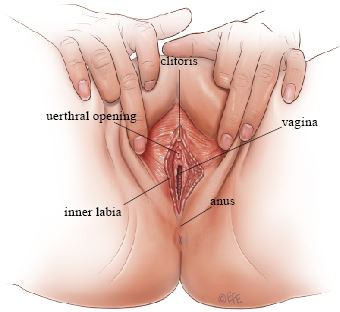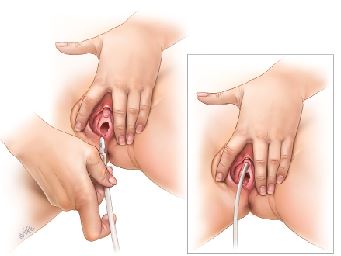Intermittent Self Catheterization
In this Health Topic
Catheterization involved passing a small tube, called a catheter, up into the bladder to empty it. Temporary catheterization is commonly required following surgery due to pain, swelling, or mobility problems. Women with neurological (nerve) problems of the bladder may need to catheterize permanently.
As urine is produced and fills the bladder, the bladder (detrusor) muscle relaxes and stretches to accommodate the fluid. When the bladder is filled to a certain level, an urge to pass urine is felt, and when it is appropriate, the brain signals the detrusor muscle to contract and the urethral sphincter to relax, thus allowing urine to be passed. The bladder usually needs to be emptied about 4-7 times per day, and once or twice at night.
Catheterization is needed when the bladder is unable to empty properly. If the bladder is unable to empty properly it can cause a number of problems, including:
- Overstretching of the bladder wall. This can lead to permanent damage to the detrusor muscle and result in urinary incontinence and a permanent inability to empty the bladder effectively.
- Urinary tract infections or bladder stone formation due to pooling of stale urine.
- Overstretching and urinary tract infections may lead to kidney damage.
- Urgency complaints (a sudden an urgent need to pass urine).
- Urge incontinence – a sudden and urgent need to pass urine that results in leakage.
There are three types of catheterization techniques:
- Indwelling urethral catheters: a tube in your bladder through the urethra which will stay in place for a short period.
- Suprapubic catheters: a tube in your bladder introduced through the lower abdominal skin.
- Intermittent catheters: a small catheter is passed through the urethra and up into the bladder and removed after each void (urination).
How long catheterization is needed will depend on the reason for incomplete emptying. If catheterization is required following surgery, the bladder normally returns to normal function after one to two weeks. Your doctor will be able to advise you on the likely length of time catheterization is required.
Before you learn the technique of ISC you must have an understanding of your anatomy to locate the opening of the urethra. Your nurse will provide you with practical information and a mirror to help you find the urethral opening.
Although it may seem difficult at first, most people find learning to catheterize very easy. With practice, emptying the bladder can take only a few minutes. Your nurse or doctor will help you find the right technique and answer questions as you learn.
- Intermittent disposable catheter(s)
- Container for urine
- Lubricant (sterile, various manufacturers)
- Toilet tissue
- Container with a well-fitting lid to store the catheter in after use
You may be advised that you can reuse your catheters, in which case:
- Rinse the catheter after use, making sure that the eye of the catheter is not blocked.
- Wash the catheter in warm soapy water, then rinse it thoroughly win clean running water.
- Shake the catheter to remove residual water.
- The catheter should be stored in a clean container that has a lid.
- Clean the container at least once a week with warm soapy water and dry it thoroughly.
- DO NOT let anyone else touch the catheter or container.
Each catheter may be used for one week. However, if the catheter appears damaged or unclean or if you are displaying signs of infection, change the catheter. In case of an infection, a NEW catheter should be used each time.
- Wash hands thoroughly.
- Prepare the equipment, setting everything up on a clean, easily accessible surface.
- Wash your genital area wit wet toilet tissue, a flannel, or wipes. Always wipe from front to back and use each tissue or wipe only once. Discard used toilet tissue into the rubbish bag or toilet.
- WASH YOUR HANDS AGAIN.
- Position yourself in the position that is comfortable for you, either sitting or standing. Until you are familiar and confident with the procedure, you may need to position a mirror to make it easier to see the opening of your urethra.
- Pick up the catheter, but do not touch the end that is going into your bladder. Dip the tip of the catheter into the sterile lubricant.

Figure 1: Parting of labia with fingers
7. Part your labia with one hand – you may need to place a finger over (or in) the vagina to prevent the catheter going into the vagina instead of the urethra. Gently insert the catheter into the urethra until urine flows. Leave the catheter in until the moment that urine stops flowing.
8. Remove the catheter slowly after the urine stops flowing.
9. Dry yourself.
10. Wash your hands.

Figure 2
Drinking. Unless your doctor has told you otherwise, you are advised to drink approximately 2 liters of fluid per day. This will help reduce the risk of urinary tract infections.
Hygiene. Safe handling is more important than speed. Always wash your hands thoroughly as is demonstrated in recommended guidelines when performing the technique and when cleaning your equipment.
Bowel Habits. It is important that your bowel functions regularly for you. This will make it easier to empty your bladder completely. Eat a well-balanced diet with plenty of fruit and vegetables. If you become constipated, contact your family physician, specialist, or nurse. For more information, see the leaflet on Fecal Incontinence.
Before Catheterization. Whenever possible, always try to pass urine the normal way before using a catheter. Try to relax your pelvic floor and avoid pressing down with your abdominal muscles.
Difficulties Inserting the Catheter. Never use force or be in a hurry when inserting the catheter. If you meet resistance when inserting, stop. Take a few slow breaths or gently cough while keeping steady pressure on the catheter. After a while the muscles will relax, and the catheter will slide in. If you continue to have difficulties, contact your health professional for advice.
Traveling. If you go away on holiday, remember to take any supplies with you. Don’t forget to pack some supplies in your hand luggage.
Blood on the Catheter. Introducing the catheter can damage the urethral tissue but the damage will soon heal. You can continue to perform ISC. If force is required or ISC gets more painful and blood loss does not stop, contact your physician.
With each introduction of the catheter there is a slight chance of urinary tract infection. This is because the catheter will provide a direct route for bacteria to enter the bladder. You are advised to seek medical help promptly for a possible urinary tract infection when you have the following symptoms:
- Feeling unwell and/or tired, loss of appetite, vomiting
- Fever, chills, shivering
- Pain or burning on passing urine or catheterizing
- Pain/aching back
- Cloudy or offensive smelling urine
- Persistent passing of blood in the urine
- A frequent need to pass urine
There will be variations to these guidelines
RESIDUAL …………………………………………………. FREQUENCY
400mls ………………………………………………………4-6 times a day
400-300mls ……………………………………………………. 3 times a day
300-200mls ……………………………………………………… Twice a day
200-100mls ………………………………………………………………..Daily
Or as often as your doctor or nurse instructs.

